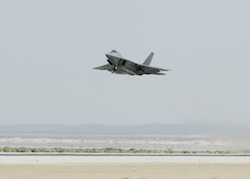The 411th Flight Test Squadron at Edwards Air Force Base successfully flew an F-22 Raptor at supercruise on March 18 on a 50/50 blend of conventional petroleum-based JP-8 and biodiesel produced from camelina. The flight was the capstone in a series of ground and flight test events where ultimately the Air Force selected the F-22 weapon system to be the biofuel blend flight test pathfinder aircraft.
The purpose of the test was to evaluate whether the biofuel blend was suitable for use in the F-22 weapon system. According to the Air Force, testing consisted of air starts, operability, and performance at different speeds and altitude throughout the flight envelope. In addition, the F-22 Raptor performed several maneuvers including a supercruise at 40,000 ft. reaching speeds of 1.5 Mach. Supercruise is supersonic flight without using the engine’s afterburner.
 “The F-22 flew on Friday, March 18 and performed flawlessly on the biofuel blend citing no noticeable differences from traditional JP-8,” said Jeff Braun, director of the Alternative Fuels Certification Division, part of the Aeronautical Systems Center at Wright-Patterson Air Force Base, Ohio.
“The F-22 flew on Friday, March 18 and performed flawlessly on the biofuel blend citing no noticeable differences from traditional JP-8,” said Jeff Braun, director of the Alternative Fuels Certification Division, part of the Aeronautical Systems Center at Wright-Patterson Air Force Base, Ohio.
The Air Force has deemed the flight a success and determined that another milestone has been completed. The Alternative Fuels Certification Division is supporting the Air Force’s 2016 acquisition goal to cost-competitively acquire 50 percent of the domestic aviation fuel requirement via alternative fuel blends.
The camelina blend that was used during this test flight falls within the parameters of this goal. More specifically, it falls into a class of hydro-processed blended biofuels known as hydrotreated renewable jet fuels, or “HRJs.” The HRJ fuel can be derived from a variety of plant oil and animal fat feedstocks. In February of 2011, Air Force officials certified the entire C-17 Globemaster III fleet for unrestricted flight operations using the HRJ biofuel blend.

